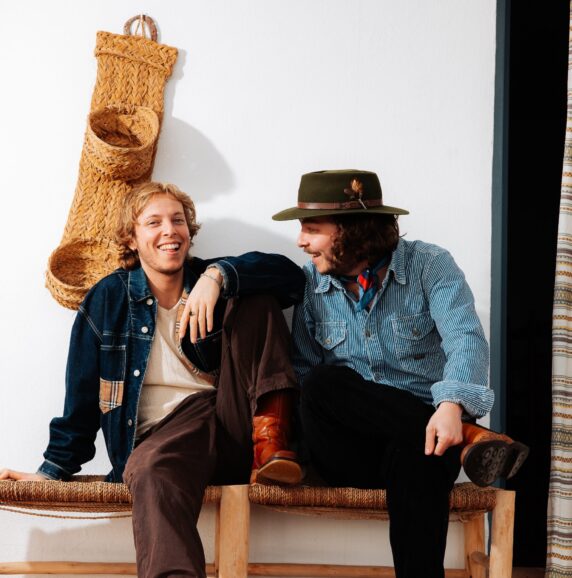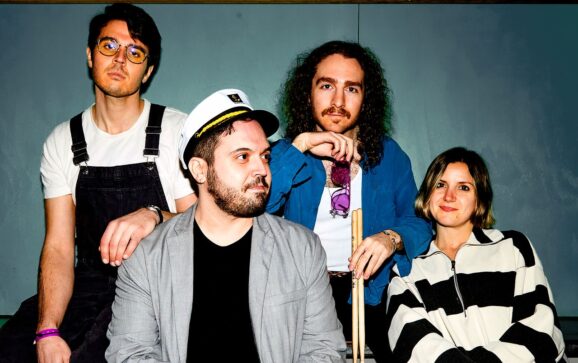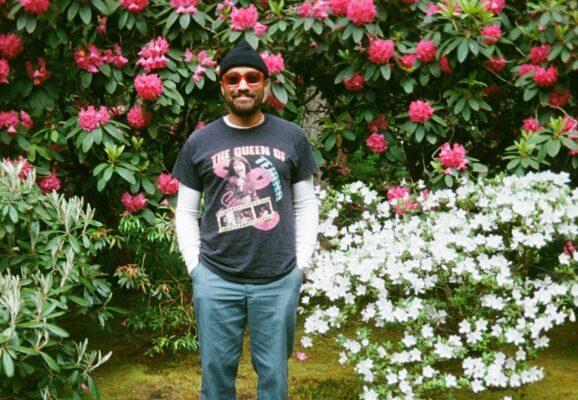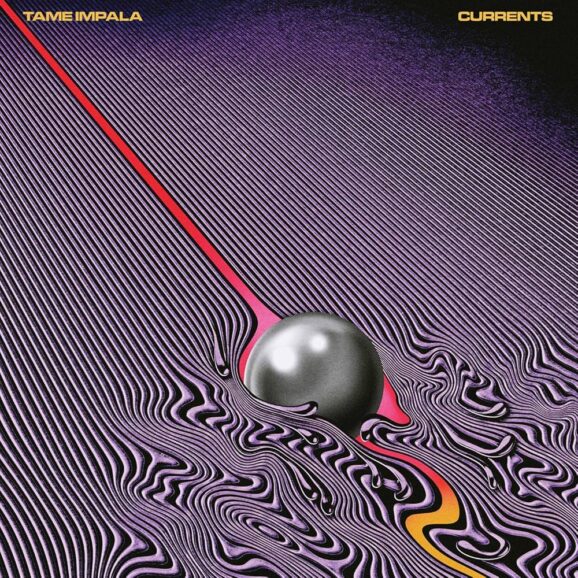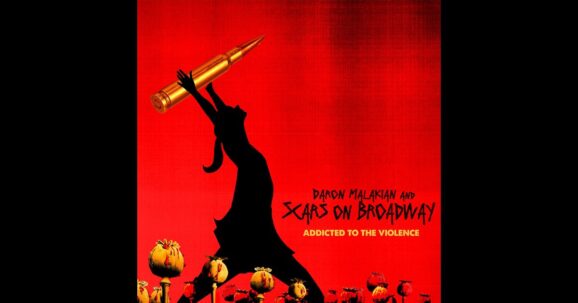The musical story of how Alan Palomo ended up creating his recently released World of Hassle LP is a beautifully unpredictable one. Palomo has been tirelessly creating otherworldly textures with synth-heavy projects, his most popular being the albums he released under the Neon Indian moniker. As the clock ticked forward, any sense of safety fell through the cracks of the pandemic and Palomo entered what we now know was a complete creative overhaul. Palomo wanted to create a mature record he could attach his government name to and the concept of World of Hassle was born. Over the next few years, Palomo will push through his meticulous creative process to emerge with the best music of his career. The dream-like textures of his namesake debut make the sensation of uncertainty feel warm and push the unpredictability of modern life to the side for 13 songs of jazz-infused pop euphoria.
Glide had the pleasure of speaking with Alan Palomo about his vibrant new album, the creative journey he took to get there, and his upcoming tour. Read our full conversation below:
World of Hassle has only been out for a few days now, have you had a chance to sit back and take it all in?
No pun intended but it feels like the weight of the world of hassle is finally off my shoulders. As somebody who likes to be involved in everything from marketing to videos, merch, and artwork, turning in the record is like making the pact to start hustling on everything else. Once it’s out it’s out of your control though, you have to let it live in people’s ears and that always comes with great relief. It’s nice to be prepping for tour and everything but it’s been a pretty wild weekend here at HQ.
What is the story behind the artwork? Can you tell me more about the fake news blurbs on there?
I did the artwork in collaboration with Robert Beatty, he’s done a lot of work for me in the past, and he’s the only guy who’s willing to entertain every dumb idea I have. He’s a big fan of graphic design, specifically what’s found in publications from that era. We really got to geek out at what the classifieds would look like, what newspaper ads would look like in the early 90’s. My favorite element of it was the movie theater track listing, I grew up checking the dollar theater listings in the newspaper so to get to slowly chip away at the artwork was an absolute joy. Robert has the same kind of brain where he enjoys tinkering away at it, I think it took a total of four months. The real motivation behind this was to create this lived-in feeling of a strange, paranoid world in which the record could live. In my head, World of Hassle sounded like a publication so when you look at the headlines, it was my attempt at making sense of the world we walked into after the pandemic. A lot of those headlines and news stories featured are me sort of grabbling with change through humor, ultimately that’s how I process most things.
How long did it take to finish the music of the album?
Honestly, the record itself only took two or two-and-a-half years to make. I had shelved another album I was working on actually, I started making a new record around 2017 or 2018, worked on that for a year, and got about 70% of the way there. I felt like there was a good single in there but I felt the record as a whole lacked cohesion and I got a little burnt out on it. Once the pandemic started, my project was to buy a piano and start learning how to sight-read, for me that’s how World of Hassle came about. It was something that started during the pandemic.
What inspired you to start going by your government name for World of Hassle?
It’s kind of a concept album. At least for me, it’s a hilarious ’80s rock cliche to leave your band in your thirties to write a sophisti-pop record. I love a lot of those records, after Bryan Ferry perfects a formula on Avalon he makes three more of those like Boys and Girls, and Sting leaving The Police to do The Dream of the Blue Turtles. Those records have always been a big influence on me but that sound just never found its way into the work in any palpable sort of way, it was just stuff I listened to in my twenties. This time around I thought to myself; “They know you know your way around a synth, you’ve made a trilogy of records that was heavy-synth-based stuff. What haven’t they heard you do yet?”. I kind of want to sweat the songwriting and vocals more, the textures will be there. I can’t help but implement that stuff into what I’m doing but as a whole, it was about not standing behind a moniker and just representing myself as a musician. It’s serving as a reintroduction in a way that many musicians have in this clunky, jazz-infused way.
So you would call World of Hassle a Sophisti-pop record?
In the ballpark of it sure. It’s a genre of an era but the palette and songwriting style is majorly informed by it.
Do you remember the specific recording session or moment when you decided to take the album in this sonic direction?
It was more of when I purchased this synth for the other record I eventually shelved. I bought this Casio that I saw in this YouTube video of these two Japanese brothers who made a whole record on this keyboard. They were selling a preset pack for it and I never realized a synth could sound like that. I bought the Casio and it was just sitting in a hallway against a wall, I kept telling myself I was going to write music with this thing. In my mind, I knew when I’m ready to make my Avalon or make an album inspired by that, I knew that was the synth I would use. So I knew from the jump World of Hassle was going to be this sort of record.
Is that your creative process on every record? You Conceptualize and go from there?
I like to, even if I fail I’ll at least land somewhere interesting. I usually need a relative direction to start running in and then obviously other things will find their way into the record. Eventually, it all manifests into this other thing that isn’t quite what you envisioned. Having a blueprint, a set of influences, and some conceptual direction is needed for me to start writing.
Do you have any rituals or habits you indulge in before you start recording?
It depends on what kind of work day it is. I always go get a ginger shot and iced cortado and think about what I want to work on. Usually, I’ll read for about an hour especially if I’m working on lyrics. I have to curate what I’m reading, listening to, and watching because it all inevitably makes its way into the work. I’ll curate a list of movies with the idea in mind that they’ll add some quality to what I’m trying to evoke in a general vibe. When I work alone, it’s a very unromantic process, it’s a lot of trial and error. I tend to drive myself nuts programming but it’s a lot more streamlined when I bring in players. That aspect of it is a lot more fun and you take on more of a directorial role where you coach performances out of the musicians you’re working with and take that work back to the home studio for editing.
What sort of stuff were you reading/consuming when working on World of Hassle?
There were two main authors. Thomas McGuane has this really great book called Panama and I believe I started reading another one of his works, Ninety-Two In The Shade. Jay McInerney is another one, I’ve always been a big fan of Bright Lights, Big City and I remember I watched the Michael J. Fox adaptation of it. Gordon Willis worked on it, no one shoots New York like him. McInerney has another book called Brightness Falls, it’s kind of like a spirit sequel. If Bright Lights, Big City is about your mid-twenties then Brightness Falls is about your early-to-mid thirties. Lyrically, I was playing with this idea of what happens when you’ve been rejected by the social contract of adulthood and you’re sort of stunted at post-adolescence. Songs like “Club People” touch on that but the album is also recognizing that the problems we had back then are the problems we have now. The hangover of the late Regan era when everything started to crash is something that, when putting together the universe of this record, was something I had in mind.
This album is being labeled as a “rebirth” for you. Do you feel that way or is this just another project and the next one might be completely different? Do you think that far ahead when creating?
My head is this disorganized stack of projects yet realized so I tend to know what I’m going to be working on for the next few years. Obviously, things pop up, different projects or production opportunities but as someone who’s more interested in working in film whether that is composing or directing, I feel comfortable just going by my name. It might as well all be under one house, if I direct a movie it’s not going to say “Directed by Neon Indian” so why should I keep putting out records like that if I’m comfortable just using my own name?
How do you approach collaboration? Does it change your creative process at all and who is on your bucket list to work with?
A more true statement would be I didn’t have a typical approach because this is the first record that I brought in collaborators, at least in terms of vocals. With Mac Demarco, that was something that happened organically. I was looking for a piano that I didn’t have access to and a keyboard player of mine mentioned that Mac had one so I texted him. We went to spend a few days in his studios and I think we stayed there for five days. He engineered the whole thing, he was really gracious with his time and creativity. The night before we started I had the idea to bring a song to Mac to see what he thinks so I put a basic demo together. I pitched it to him and it grew from there. As far as Flore Benguigui goes, I had her in mind simply because I was a fan. It was my friends from Pearl & The Oysters who got me in touch with her, they knew each other from back in the day. My collaborations tend to be pretty organic, it’s never a formal “one manager to another” sort of thing. In this case, it wound up being friends or friends of friends.
Where did the title World of Hassle come from and what sort of emotions does it evoke for you?
The line is from “Inherent Vice” and the sentence was something along the lines of “Unbeknownst to him, he was entering a world of hassle”. I think that’s how everyone felt going into COVID, the veneer of safety and control just quickly dissipated and we were thrown into this world of paranoia. The reason I love fiction novels is because the protagonist is always the butt of someone’s jokes and their job is to find what unforeseen entity is throwing their life into chaos. It felt that way even trying to finish the record, I would run into these bizarre situations. As per a punitive demand of the city, my landlord had to renovate all this stuff so I would be trying to record vocals and all of a sudden this construction crew moved into the building and were there for a few months. I would try and work at night then this nightingale bird parked itself outside of my window so I would keep getting bird chirping in the takes. I had to figure out how to humanely scare away this nightingale. Apparently, if you play a competing bird song you can trick it into thinking there’s a competing Chad bird in its midst and it will go away. That didn’t work so I would go to the studio but the studio was over a bar so after 6 p.m. it was just too much noise. It was really a World of Hassle trying to finish this record it really earned its namesake. It was all worth it though.
What was it like sequencing the whole album?
That always happens in mastering, that’s where Heba Kadry really shines. She is a collaborator I’ve had since the last record and I really love the job she did on that one. We usually set aside two days to hang out and work on it. I usually know the track order but it’s more based on questions like “Is this one going to bleed into the next?” or the pauses in between songs. It always feels like an afterthought but these are the labor of love type details that we like going into. Most of that happens at Kadry’s studio.
You’re about to head out on tour, how did you assemble your band for the live shows? Are there any songs from the album you’re particularly excited to perform?
When putting together a band, you have to think that this is someone I’m going to be in a van with for months at a time. Half of the criteria are “Are they a good hang” or “Do I already know them”. With the last record, when my brother joined the band, I knew I had to find players who could speak his language musically. He’s a Berklee-trained jazz guy and I happened to know two guys who I met in Texas who attended Berklee, they were best friends so they were essentially a package deal. Ever since they joined the band, it made me have to up my chops. I quickly realized I was the least technically proficient member of my band but obviously, I like it to be those criteria. I’ve never done auditions or anything like that, it’s usually someone my brother or I are familiar with.
We’re touring the album so we’re going to be playing mostly new stuff. I’m not trying to alienate any Neon Indian fans so there’ll be plenty of that too.
Your music has taken on many forms, how do you feel you’ve personally evolved as an artist?
There’s more confidence in my singing. The flirtation with jazz and changing up the compositions to be a little more predictable have been a big motivating factor for me. When I started making music it was very sample-heavy and the limitations of sampling kind of lock you into one key, starting to branch away from that and build songs from scratch has made it so I can take it in all these different directions.
When did your fascination with Jazz start? What sort of music did you grow up listening to?
I remember seeing “Pyramid Song” by Radiohead on MTV2 in middle school. My mom got me the CD for my birthday and that was the beginning of me diving into it. When I say “Jazz” I should specify that I’m talking about Steely Dan or Michael McDonald, people who have infused it into pop music. I love John Coltrane records but I like that intersection between these more advanced styles of music and pop. The genres of Brazilian Boogie and City Pop helped me realize stuff like “Okay Brazil has its own way of incorporating Bossa Nova into their style” and City Pop is like yacht rock, R&B type music and adding Japanese sensibilities in which the compositions become more complex and the chord voicings become more interesting, these fusions sparked my interest. Maybe as I get older I’ll get more into jazz in the traditional sense of the word but in the interim, I like it when it’s at the intersection of these other genres.
Is there anything you hope people take away from World of Hassle or are you just happy the music is finally out there?
I think the latter, I can be methodical to a point but I can’t tell people what to take away from it. That’s the beautiful part, the music doesn’t belong to me once it’s out and people can make their own association with it and that’s why you do it.



